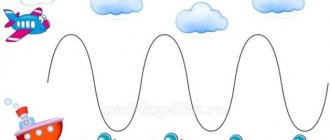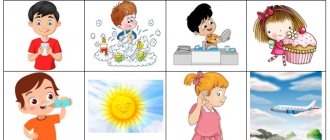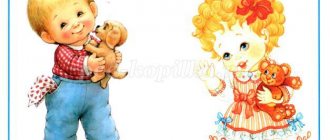Elimination of confusion in writing the letters i-u, l-m in primary schoolchildren.
Task 3
. Write the words in two columns: in the first - with the letter “l”, in the second with - “m”. (Words suggested: varnish, poppy, puddle, chalk, boat, car, treasure, watering can, fly...)
Stage 6
. Differentiation of “l-m” in phrases. Task 1. Decipher the phrases by inserting the required letter “l-m” instead of the period. Zo.otoy ku.on .o.dress ba. Heavy.blanket.Sunflower oil.Sunflower oil.U.fish.adenza.
Stage 7
. Differentiation of “l-m” in sentences, proverbs, sayings. Task: Insert the letters “l-m”.
• In do.gah – as in she.kah. • Silence is a sign of congruent Asia. • Bring your teeth back to life. • Go.ova is gray-haired, but her soul is .young. • U.enie – po.ovina de.a. • Whoever eats eats. • If only there were no bush. mi., so.ovey nests b not vi. • Where there are many s.ov, that. little de.a. • U.elgo according to the s.ovs - un.elgo according to the .asics to see. • S.ovo tale. – str.u pos.al, pis.o writ. - the priest is in a trap. .
Stage 8
. Differentiation in texts.
Auditory dictation
. The sun's rays illuminated the earth. The bells rang throughout the square. People walked in crowds and sang. It was the month of May. I admired the young greenery.
Having tested these methods on my students in grades 2-3 at State Educational Institution No. 1607 in Moscow, I had the opportunity to observe how their level of self-control increased every day. When writing down words and sentences, I saw how diligently they stretched out their lips (when pronouncing words with the sound “u”) or, conversely, stretched them (when pronouncing the sound “i”), each time making fewer and fewer mistakes. It was interesting to notice how at first the children opened their mouths slightly, feeling the tongue rising upward (when pronouncing words with the sound “l”), or closed their lips (when sounding “m”) and wrote down the required number of elements. While working with parents, I also explained to them what to pay attention to. When children performed written work at home, parents first reminded them of this, and later began to celebrate their independent completion of these “exercises,” thereby achieving the necessary results. Thus, by the end of the year, out of 8 identified students with the described disorder, 7 had their errors completely eliminated, and 1 had their number sharply reduced (I associate the residual effects with rare attendance at speech therapy classes due to the child’s frequent illness.) Literature.
1. Articulation of sounds in a graphic image. Educational and demonstration material. Appendix to the book by E.V. Novikova “Speech therapy alphabet. New methodology for teaching reading." - M.: Publishing house. GNOM and D, 2003.
2. Efimenkova L.N. Correction of oral and written speech for primary school students: A manual for speech therapists. – M.: Humanite. publishing center VLADOS, 2001.
3. Lalaeva R.I. Speech therapy work in correctional classes: Book. For a speech therapist. – M.: Humanite. published VLADOS center, 1999.
4. I.N. Sadovnikova Impaired written speech in younger schoolchildren: Textbook - M.: VLADOS, 1997.
5. Paramonova L.G. Prevention and elimination of dysgraphia in children. St. Petersburg, ed. "UNION", 2001
Corrective and developmental tasks.1. Continue teaching the child to distinguish non-speech sounds.
2. Prepare the child for mastering the sound-syllable series by forming spatio-temporal representations.
3. Carry out auditory-pronunciation differentiation of the sounds [A], [O], [I], [U], paying special attention to the comparison of the following pairs: [O] - [U], [A] - [O].
4. Form the child’s phonemic representations based on the sounds [A], [O], [U], [I].
5. Strengthen the skill of determining the place of a vowel sound in a stressed position in a word (beginning, middle, end of the word).
6. Learn to analyze a sound series of four elements.
Task 1. Didactic exercise “Seller and buyer” (development of auditory attention).
An adult pours cereal into opaque jars: semolina, buckwheat and peas. A child (buyer) asks to sell him some cereal. An adult (seller) invites the child to choose the desired cereal by sound (the child shakes the jar and guesses what kind of cereal it is by the characteristic sound).
Task 2. Didactic exercise “Before - between - after” (clarification of space-time concepts).
An adult names a series of numbers from 1 to 10 and asks which number in the series is first, last, what number comes before the number 7, after it, between 8 and 10? (The game is played without visual reinforcement.)
Task 3. Clarification and differentiation of sounds [A], [O], [U], [I].
The adult pronounces the girls' names, and the child says the first sound in each name: Anya, Olya, Ulya, Ira.
Repeat with your child the articulation of vowel sounds. Their symbols, designation (red circles). Why are they called vowels?
Didactic exercise “Guess the sound from the description.”
The adult shows the articulation of a familiar vowel sound, and the child guesses what sound it is, for example, the lips stretch out like a tube - the sound [U].
The adult shows the articulation of the sound line, and the child guesses from the silent articulation what the adult “said” (for example, “smile tube” - UI).
The adult asks the child to listen carefully and repeat after him a series of sounds: AIU, UIA, IOAU...
Task 4. Didactic exercise “Clap your hands.”
The adult invites the child to listen carefully to the pronounced vowel sounds and clap their hands only on a certain sound (for example, on the sound [A]):
a, and, a, o, and, y.
The game is played similarly with other sounds.
Task 5. Listen to a series of words and name the extra one (starting with a different sound):
Anya, August, autumn, orange; Olya, vegetables, ears, windows; Ira, willow, Inna, duck; mustache, duck, autumn, ears.
Task 6. Didactic exercise “Give gifts to Anya, Ula, Olya, Ira” (remember words starting with the sounds [A], [U], [O], [I]).
Task 7. Look at the pictures that were previously pasted into the notebook and name objects that begin with the sounds [A], [O], [U], [I].
Task 8. Didactic exercise “Choose pictures.” The adult invites the child to choose from a number of drawn objects those whose names begin with a certain sound (for example, the sound [A]).
Task 9. Remember riddles, poems based on the sounds [A], [O], [U], [I].
Task 10. An adult asks the child to complete the sentence with one word; name the first sound in each of these words. You can use pictures as a hint.
They put a television... (antenna) on the roof. The soldier shoots from... (machine gun). The hare has long... (ears). The student teaches... (lessons). The golden season has come... (autumn). They grew...(vegetables) in the garden. Masha threads a thread into... (a needle). They bought Masha a new... (toy).
Task 11. An adult pronounces a word and invites the child to indicate the place of a certain sound in it (beginning, middle, end of the word), using a card and a red circle.
[A]: August, hand, poppy; [O]: Olya, cat, coat; [U]: ears, writing, soup; [I]: Ira, rice, boots.
Task 12. An adult pronounces the beginning of a word and asks the child to finish the last syllable and name the last sound:
kengu... (ru), sapo... (gi), molo... (ko), ru... (ka).
Task 13. Exercise to develop coordination of speech and movements.
We went into the forest, - The child is marching.
They found the ax, - Stopped.
Wood was chopped - Legs - shoulder-width apart, hands - in a “lock” -
- Ah! Oh! Wow! Their! - Vigorous bending.
Task 14. Consolidating knowledge of the letters A, O, U, I. Exercises for fingers: letters A, O, U from fingers (see topics No. 1, 2, 3, 4);
repeat humorous poems about these letters, remember what else they look like;
repeat games with the letters A, O, U, I.
Task 15. Analysis of a sound-letter series of four elements: AOUI, IUAO, UIOA, OAUI, etc.;
Laying out diagrams from red circles; drawing up letter sequences according to the instructions of an adult, reading (goal: developing the skill of smoothly reading letter combinations of different numbers of vowels), copying, writing in block letters under dictation.






